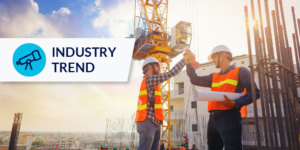
A divide between construction sectors has become visible as residential contractors brace for recession — but commercial and industrial building continue to boom.
“Rising interest rates have already driven the single-family homebuilding market into recession, but brisk nonresidential activity continues,” said Associated Builders and Contractors’ chief economist Anirban Basu last month. Recent news buzz has drawn the same consistent conclusion.
But despite what appears to be a clear divide between these sectors, it’s hard to get an accurate gauge on profit expectations due to price inflation, product availability, and higher staffing costs across the board. Until more data is available, outlooks for each industry are less than crystal-clear.
As recent trends indicate, costs of materials, fulfillment, labor, and land have surged. This has had a direct impact on the residential construction industry. CNBC reports eight months of steady decline, calling the state of the industry “negative territory.” However, commercial and industrial construction work continues to be in high demand.
Commercial construction continues to rise despite residential construction faltering
The commercial and industrial construction sector seems to have dodged a bullet — at least so far. The Associated Builders and Contractors (ABC)’s Construction Backlog Indicator shows a sustainable level of projects for the future. In August, the industry held 8.7 months of backlog — a number that has doubled since last year.
One contributor to the nonresidential industry’s optimistic outlook could be the passage of last year’s infrastructure bill, which skews heavily in favor of commercial, industrial, and infrastructure projects nationwide. The $1 trillion bipartisan plan is set to distribute funds for projects across many sectors: roads and bridges, public transit, water and wastewater, passenger and freight rail, and airports.
Additionally, the negative outlook in the housing market may be creating an even greater perception of discrepancy between the two areas of construction, with higher mortgage rates weighing heavily on demand — or lack thereof — for new housing.
Ken Simonson, Chief Economist for the Associated General Contractors of America, references two indexes — the Architecture Billing Index and the Dodge Momentum Index — that provide insight into billings and backlogs, and each source shows a strong commercial outlook.
The Architecture Billing Index indicates construction spending on new, non-residential buildings will be increasing.
“It’s a very favorable indicator for continued growth in non-residential building construction,” Simonson says.
In addition, the Dodge Momentum Index looks at projects about a year away from starting. Their index indicates growth for both commercial and institutional projects.
However, while the infrastructure bill and associated indexes seem promising, economists speculate that their execution may be difficult for various reasons. First of all, the trickle-down rate of federal money can be slow. In addition, a boom in projects in the same sector might cause a shortage of skilled workers. There are only so many specialized tradesmen to go around.
Global complications in recent years pose also challenges for the United States’ construction industry. The war in Ukraine has disrupted the supply chain of natural gas and oil, and the material supply chain has yet to completely stabilize since the effects of the COVID-19 pandemic.
With a range of positive and negative influences surrounding the state of the construction industry, it may be impossible to predict what the next few years look like.
Simonson, however, remains optimistic: “I don’t think that we’re in recession,” he said, “and I think that we’ll escape without a recession.”